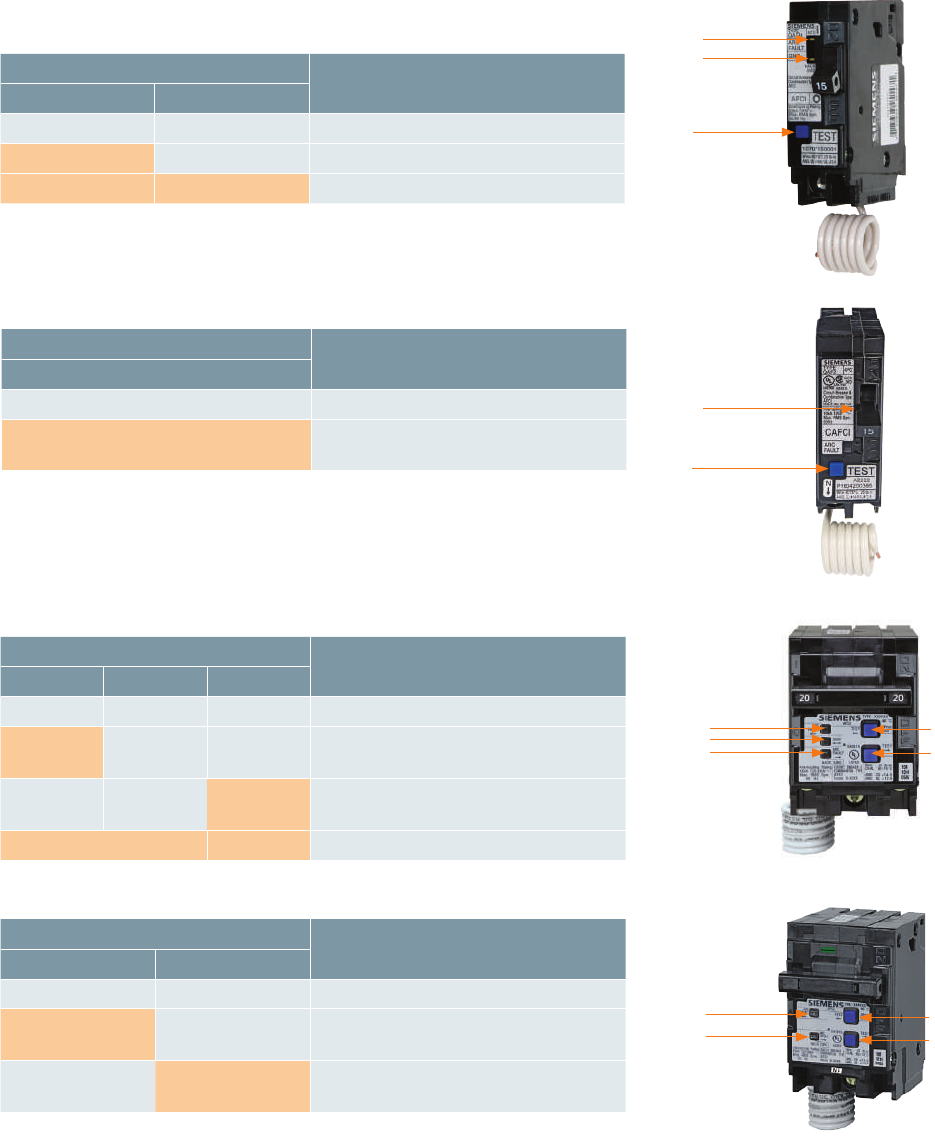
siemens.ca/powerdistribution
AFCI-GFCI Circuit Breaker
Diagnostic Guide
2 3
AFCI/GFCI Circuit Breakers | Diagnostic Guide AFCI/GFCI Circuit Breakers | Diagnostic Guide
Index
1. AFCI/GFCI circuit breaker diagnostic 3
1.1. Facts about arc faults 3
1.2. Facts about ground faults 3
1.3. What is nuisance tripping? 3
2. General diagnostic guide 3
2.1. Identification of circuit breaker types 4
2.2. General investigation 6
2.3. General diagnostic questions 8
3. Electrical professional diagnostic guide 8
3.1. Arc fault investigation 9
3.2. Arc fault diagnostic questions 10
3.3. Ground fault investigation 11
3.4. Ground fault diagnostic questions 11

2 3
AFCI/GFCI Circuit Breakers | Diagnostic Guide AFCI/GFCI Circuit Breakers | Diagnostic Guide
Hazardous voltage.
Will cause death or serious injury.
Turn off the branch circuit breaker
in the load center before checking
any cords, plugs, or wires.
1. AFCI /GFCI circuit breaker diagnostic
This document will support to better understand and diagnose
circuit breaker trip events with Siemens Arc Fault Circuit
Interrupter (AFCI) and Ground Fault Circuit Interrupter
(GFCI) circuit breakers.
The questions in this document are applicable to all branch
circuits fed by arc fault circuit interrupters (CAFCI or AFCI/GFCI)
or ground fault interrupters (GFCI or GFEP). This document is
to be used by Siemens application engineering, technical
support and sales teams, distributors, electrical contractors
and homeowners/end-users to provide application and
diagnostic feedback.
This document does not cover the diagnostics of standard
circuit breakers.
Qualified person
Circuit breakers should only be operated, inspected, and
maintained by qualified personnel. For the purpose of this
Guide, a qualified person is one who is familiar with the
installation, construction, and operation of the equipment,
and the hazards involved. In addition, he/she has the
following qualifications:
a) Is trained and authorized to energize, de-energize, clear,
ground and tag circuits and equipment in accordance with
established safety practices.
b) Is trained in proper care and use of protective equipment in
accordance with established safety practices.
c) Is trained in rendering first aid.
1.1 Facts about arc faults
Every year, residential electrical fires account for hundreds
of deaths, thousands of injures, and hundreds of millions
of dollars in property damage. A significant number of these
electrical fires could have been prevented if the circuits had
been protected by arc fault circuit interrupters circuit breakers.
An arc fault is a high-energy discharge created by current
flowing through an unwanted path. Generally, arc faults
are of short enough duration that they are not detected by
standard thermal magnetic circuit breakers. However, arc
faults can produce high-intensity heat – exceeding 10,000
degrees Fahrenheit – and can initiate fires. To mitigate fires
due to arc faults, AFCIs monitor the branch circuits and
mitigate the effects by de-energizing the circuits once an
arc-current signature is detected.
1.2. Facts about ground faults
A ground fault circuit interrupter (GFCI or GFI) and a ground
fault equipment protection (GFEP) device is a safety device
intended to provide protection from unintentional electrical
currents between a power source and a grounded surface. An
electrical shock, even in the low milliamps, flowing through a
body can cause injury or death.
The GFCI and GFEP circuit breakers work by comparing the
amount of current going to and returning from a branch
circuit. If the current differs by a defined value the GFCI or GFEP
circuit breaker will trip, thus shutting off power to the circuit.
Siemens offers Class A 5mA GFCI and 30mA GFEP circuit breakers
for their residential load centers. While the GFCI circuit breaker
provides personal protection from shock the GFEP circuit
breakers provides equipment protection from line-to-ground
faults that would damage equipment if left uninterrupted.
1.3 What is nuisance tripping?
In some situations, the homeowners/end-users and/or
electrical contractors may experience a phenomenon called
nuisance tripping. This occurs when the AFCI or GFCI circuit
breaker trips and the reason is unknown. The main sources of
nuisance tripping are wiring issues and incompatibility with
electronic devices. Wiring issues such as damaged wires, loose
connections, or incorrectly wired circuits are some examples
of conditions that can create nuisance trip events. To resolve
nuisance trip events associated with wiring issues the source
of the issue will need to be corrected. Incompatibility issues
can be created by loads that produce excessive noise that
eventually mimics an arc. It is recommended that all installed
electronic devices comply with CSA standard to avoid noisy
loads from causing
nuisance trips.
2. General diagnostic guide
Should a trip condition occur, homeowners should first note
the specific circuit the circuit breaker is protecting, per the
load center circuit label (e.g. kitchen, bed room, living room,
lighting, etc.), and while the circuit break is in an ‘OFF’ state,
confirm that there are no obvious issues with the loads on
that circuit follow these steps:
1. Check for any blackened plugs or outlets. If found,
remove all plugs from the outlet and contact an
electrical contractor for further investigation.
2. If there are lights on the circuit, check for loose
connections between the light bulbs and sockets.
3. Check for any damage or crimps in all electrical cords
plugged into an outlet on the circuit. Possible conditions
contributing to cord damage:
a. Cords are pinched in doorways.
b. An appliance or furniture is pushed against electrical
plug or resting on a cord.
c. Cords deteriorated due to proximity to heat source
(e.g: heaters, hot air ducts, sunlight, etc.).
4. Ensure all bulbs are less than or equal to the maximum
wattage rating of the fixture. Higher rated bulbs can
cause excessive heat and damage.
5. Unplug all equipment on the affected circuit.

4 5
AFCI/GFCI Circuit Breakers | Diagnostic Guide AFCI/GFCI Circuit Breakers | Diagnostic Guide
6. Reset the circuit breaker by actuating its handle to the ‘OFF’
and then ‘ON’ position. If the circuit breaker trips again, a
fault still exists on the circuit. Observe and record the trip
indicator LED lights. Call an electrical contractor to
investigate the issue.
7. If the circuit breaker does not trip after all equipment has
been unplugged follow these steps:
a. Turn on and off each light individually, if lights are on
circuit, and observe if circuit breaker trips.
b. Plug in non-defective equipment one at a time, turn
on and off and observe if circuit breaker trips.
Note: If circuit breaker trips during step 7, remove the equipment or light
that caused a trip event from the circuit before reenergizing the circuit
again and call an electrical contractor.
Helpful tip: Surge protectors are recommended to protect
devices from electrical voltage surges. They may also provide
the added benefit of filtering unwanted electrical noise
sometimes generated by electrical devices. This unfiltered
electrical noise could affect the AFCI/GFCI circuit breaker and
potentially interfere with or damage other electronics on the
circuit. Ensure all electronic devices (e.g: TV, DVR, computer,
etc.) are plugged into a surge protector specifically designated
with EMI/RFI filtering functionality.
Please contact your electrical contractor and provide the
following answers to the General diagnostic questions
under section 2.3.

4 5
AFCI/GFCI Circuit Breakers | Diagnostic Guide AFCI/GFCI Circuit Breakers | Diagnostic Guide
Branch Feeder Arc Fault Circuit Interrupter (AFCI)
Teal Test Button
1 Pole
Gen. 1 Gen. 1B
Dual Function Arc Fault Circuit Interrupter (DF)
Light Blue Test Button
1 Pole
Gen. 2
Date Code
Date Code
Date Code
Trip indication
see 2.2.5
Trip indication
see 2.2.5
Ground Fault Equipment Protection (GFEP)
Red Test Button
1 Pole
Gen. 1 Gen. 2
2 Pole
Gen. 1
Date Code
Combination Arc Fault Circuit Interrupter (CAFCI)
Dark Blue Test Button
1 Pole
Gen. 1 – 3A Gen. 3B
2 Pole
Gen. 1 Gen. 3B
Date Code
Date Code
Date Code
Date Code
Trip indication
see 2.2.1
Trip indication
see 2.2.3
Trip indication
see 2.2.4
Trip indication
see 2.2.1
Trip indication
see 2.2.2
Ground Fault Circuit Interrupter (GFCI)
White Test Button
1 Pole
Gen. 1 Gen. 2
2 Pole
Gen. 1 Gen. 1B
Date Code
Date Code
Date Code
Date Code
Trip indication
see 2.2.6
No Trip
indication
No Trip
indication
Trip indication
see 2.2.6
Trip indication
see 2.2.7
Trip indication
see 2.2.7
Trip indication
see 2.2.7
2.1 Identification of circuit breaker types
If no issues are found, please identify the circuit breaker type and manufacturing date codes per the following identification guide.
These pictures are intended to be representative samples, and your actual circuit breaker configuration may not be specifically
pictured. Plug-on neutral circuit breaker will not have pig-tail leads.
Date Code
Date Code

6 7
AFCI/GFCI Circuit Breakers | Diagnostic Guide AFCI/GFCI Circuit Breakers | Diagnostic Guide
2.2 General investigation:
2.2.1 1 pole Gen. 1 – 3A CAFCI and Gen. 2 DF circuit breaker
trip-indicator LED lights:
LED 1
LED 2
Test
Button
LED indicators Last known trip condition
1 2
Off Off Overcurrent
On Off Arc-to-Neutral or Series Arc Fault
On On Ground Fault or Arc-to-Ground
Note: The trip-indicator LED lights on a Gen.1-3 CAFCI and Gen. 1 DF circuit breaker provide
the same fault indications.
LED 1
Test
Button
LED indicators Last known trip condition
1
Off Overcurrent
On
Arc-to-Neutral or Arc-to-Ground or
Series Arc Fault
Note: The 1 Pole Gen. 3B CAFCI circuit breaker does not offer ground fault protection.
2.2.2 1 pole Gen. 3B CAFCI circuit breaker trip-indicator LED lights:
LED 1
LED 2
Test
Buttons
LED indicators Last known trip condition
1 2
Off Off Overcurrent
On Off
Arc-to-Neutral, Arc-to-Ground or
Series Arc Fault or (leg A)
Off On
Arc-to-Neutral, Arc-to-Ground or
Series Arc Fault or (leg B)
2.2.4 2 pole Gen. 3B CAFCI circuit breaker trip-indicator LED lights:
Note: The 2 P Gen. 3 CAFCI circuit breaker does not offer ground fault protection.
LED 1
LED 2
LED 3
Test
Buttons
LED indicators Last known trip condition
1 2 3
Off Off Off Overcurrent
On Off Off
Arc-to-Neutral or Series Arc Fault
(leg A)
Off Off On
Arc-to-Neutral or Series Arc Fault
(leg B)
On On On Ground Fault or Arc-to-Ground
2.2.3 2 pole Gen. 1 – 3A CAFCI circuit breaker trip-indicator LED lights:

6 7
AFCI/GFCI Circuit Breakers | Diagnostic Guide AFCI/GFCI Circuit Breakers | Diagnostic Guide
Ind 1
Test
Button
Window indicator Last known trip condition
1
Blank Overcurrent
Yellow Ground Fault
2.2.6 1 pole Gen.1 GFCI and Gen. 1 GFEP circuit breaker trip-indicator:
LED 1
Test
Button
LED indicator Last known trip condition
1
Off Overcurrent or Ground Fault
Blinking Circuit breaker needs to be replaced
2.2.7 1 pole Gen. 2 GFCI, 2 pole Gen. 1B GFCI, and 1 pole Gen. 2 GFEP
circuit breaker trip-indicator:
LED 1
LED / Window indicator Last known trip condition
1
Off / Blank Overcurrent or Ground Fault
On / Yellow Arc-to-Neutral, Arc-to-Ground
2.2.5 1 pole Gen. 1 – 1B AFCI (branch feeder) circuit breaker trip-indicator:
Test
Button

8 9
AFCI/GFCI Circuit Breakers | Diagnostic Guide AFCI/GFCI Circuit Breakers | Diagnostic Guide
2.3 General diagnostic questions
1. *What type of circuit breaker is tripping?
2. *What are the date codes on the circuit breaker?
3. *What LEDs are lit on the circuit breaker after it tripped and is reset?
4. *What action/event caused the circuit breaker to trip? (For example: Turning on/off an appliance/device)
5. What is the load center circuit number and description?
6. Are there combinations of loads that cause the trip condition?
If yes, what are the devices (make and model)?
7. How often does the circuit breaker trip?
8. Did the action/event on another circuit coincide with the trip event?
If not, which circuit tripped and on which circuit was the action/event?
9. Please specify property type – single family home/apartment complex/etc.
If other than single family home, how many units?
Please answer questions 1 through 8 per unit or provide common information such as all the kitchen breakers are tripping.
Note: Answers to these questions will assist the electrical contractor narrow down the source of the trip condition. This will shorten the diagnosing time
and reduce the number of visits required to solve the issue. Answers to the questions that are listed with red * are mandatory information needed to
understand the issue and escalate to an clectrical contractor.

8 9
AFCI/GFCI Circuit Breakers | Diagnostic Guide AFCI/GFCI Circuit Breakers | Diagnostic Guide
3.1 Arc fault investigation
Follow the steps below to diagnose the root cause of a
trip-condition on a circuit protected by an AFCI circuit breaker:
1. Ensure the previously-mentioned ‘General Diagnostics’ tips
have been reviewed.
2. Check to make sure the breaker is functioning properly
via the ‘TEST’ button. Move handle to the ‘OFF’ and then ‘ON’
position. Reset has been completed, press the ‘TEST’ button
and observe the position of the circuit breaker’s handle. If
the breaker handle moves between the ‘OFF’ and ‘ON’
position, then the circuit breaker is working correctly. If the
circuit breaker does not trip, it needs to be replaced by an
electrical contractor. Observe and record the trip indicator
LED lights.
3. When checking for a loose light bulb, check that the line/hot
tab on a light socket makes a good connection to the bulb.
If not, with the light fixture disconnected from the circuit,
bend the hot tab upward slightly so it will make a good
connection to the bulb and retighten the bulb in the socket.
4. Check the wiring at the circuit breaker load terminal (line/
hot, load neutral, panel neutral/pig tail). Ensure the load
neutral conductor is properly connected to the neutral
terminal of the circuit breaker and the circuit breaker
neutral/pig tail is properly connected to the neutral bar. In
case you have a plug-on neutral AFCI or GFCI circuit breaker
you will not have a panel neutral/pig tail.
5. Check the wiring to ensure a single pole AFCI circuit breaker
is not wired to a multi-wire branch circuit (shared neutral).
For multi-wired branch circuits where the neutral is shared
between two branch circuits, a two-pole AFCI circuit breaker
must be used.
6. Check the load center, switches, receptacles, and hardwired
lighting/appliances for loose connections. Siemens highly
recommends using screw connections for wire termination
on all outlets, switches, etc, instead of using the spring-
loaded ‘push-in’ connections. Ensure all screws and lugs
are tightened to specification.
7. Check the installed wiring for damaged insulation that may
expose hot wires to neutral or ground wires.
8. Check all devices for cUL and CSA compliance (LED lights,
powerline adapters, etc…). If not, check with the supplier/
manufacturer to validate its compliance with CSA for residential
environments. If not, the device may be producing enough
electrical noise to affect all electronics on the circuit (including
the AFCI circuit breaker).
9. If the arc-fault trip condition persists after all the wiring has
been verified follow these steps:
a. Disconnect all the loads on the circuit.
b. Energize each load individually until the AFCI circuit
breaker trips.
c. Move the latest energized load before the trip – where
possible – to another circuit to see if the trip condition
follows a specific device.
d. When the circuit breaker trips, the most recently energized
load is likely producing the arc-fault signature.
e. If the circuit breaker still does not trip, then test the loads
in different combinations.
f. If a combination of loads is required to trip the AFCI
circuit breaker, isolate each of the loads again and, this
time, test the isolated loads in combination with a 5A
resistive load such as a portable heater (600W or higher).
g. If the AFCI circuit breaker trips on an arc fault when
the isolated load is tested in combination with the 5A
resistive load, the isolated load is most likely producing
the arc-fault.
If the source of the trip conditions is still not determined,
complete the General diagnostics questions under section
2.3 and Arc fault diagnostic questions under section 3.2 in
their entirety, and then contact Siemens Technical Support.
Answers to these questions are critical to Siemens understanding
of the type of tripping event.
3. Electrical professionals diagnostic guide
Diagnostics of electrical circuits should only be done by a
qualified electrical contractor. The first step in diagnosing
the root cause of a circuit breaker trip is to eliminate the
most common and routine causes. The most common and
routine causes of circuit breaker trip events are loose
connections, misapplied/damaged appliances, and/or
incorrectly wired outlets and circuit breakers.
Gently pull up tab
indicated in square
Hazardous voltage.
Will cause death or serious injury.
Turn off and lock out power
supplying equipment before working
on equipment.

10 11
AFCI/GFCI Circuit Breakers | Diagnostic Guide AFCI/GFCI Circuit Breakers | Diagnostic Guide
3.2 Arc fault diagnostic questions:
1. Can the trip be traced to a specific light switch or ceiling fan speed control switch? If so, please provide make and model
and approximate distance between the switch and load:
2. For LED or low-voltage lighting fixtures, provide the make and model of the lighting fixture and the switching power
supply /electronic transformer:
3. What is the current draw of the load or the combination of loads that are causing the arc-fault condition?
4. What type of communication modem is used in the house (WiFi, power line communication (PLC), broadband power
line (BPL), etc) and is it related to the trip condition?
5. What is the make and model of the appliance or device? How many are installed on the circuit?
For additional AFCI resources, please reference the following links:
Siemens Documentation (including additional diagnosing information): www.usa.siemens.com/afci
AFCI Diagnostic Tool Video: www.usa.siemens.com/intelliarc
Free Online Training: www.afcisafety.org

10 11
AFCI/GFCI Circuit Breakers | Diagnostic Guide AFCI/GFCI Circuit Breakers | Diagnostic Guide
3.3 Ground fault investigation:
Follow the below steps to diagnose a ground fault trip-condition:
1. Check the wiring to ensure a single pole AFCI, AFCI/GFCI,
GFCI, or GFEP circuit breaker is not wired to a multi-wire
branch circuit (shared neutral). For multi-wired branch
circuits where the neutral is shared between two branch
circuits, a two-pole AFCI, GFCI, or GFEP circuit breaker
must be used.
2. Check the wiring at the circuit breaker load terminal (line/
hot, load neutral, panel neutral/pig tail). Ensure the load
neutral conductor is properly connected to the neutral
terminal of the circuit breaker and the circuit breaker
neutral/pig tail wire is properly connected to the neutral
bar. In case you have a plug-on neutral AFCI/GFCI circuit
breaker, you will not have a panel neutral/pig tail.
3. Ensure neutral conductors have not inadvertently been
connected to a ground conductor at any point in the circuit.
4. Using a leakage current clamp meter on the ground
conductor, test loads on the affected branch circuit to
confirm if any load creates enough leakage to trip the
connected circuit breaker.
5. Check to see if the trip condition is repeatable. If a ground
fault exists on the circuit the circuit breaker will immediately
trip after a completed reset. An arc-to-ground will not be
readily repeatable. If an arc-to-ground is suspected refer to
the Arc fault investigation section.
If the source of the trip conditions is still not determined,
complete the General diagnostics questions under section
2.3 and Ground fault diagnostic questions under section 3.4
in their entirety, and contact Siemens Technical Support.
Answers to these questions are critical to Siemens
understanding of the type of tripping event.
3.4 Ground fault diagnostic questions
1. If the ground-fault condition occurs on a pool/spa pump system, please answer the following questions:
a. What is the make and model of the pump system?
b. What is the type of drive installed? (e.g: variable flow, variable frequency, etc.)
c. What accessories are used with the pool pump/filtration system?
Provide bill of material and wiring diagram if possible.
2. If the source of the ground-fault condition is a fan or appliance, please answer the following questions:
a. What is the make and model of the speed control fan or appliance?
b. Does the installation or use and care guide recommend or reject a circuit breaker type?
Hazardous voltage.
Will cause death or serious injury.
Turn off and lock out power
supplying equipment before working
on equipment.

This document contains a general description of available technical
options only, and its effectiveness will be subject to specific variables
including field conditions and project parameters. Siemens does not make
representations, warranties, or assurances as to the accuracy or
completeness of the content contained herein. Siemens reserves the right
to modify the technology and product specifications in its sole discretion
without advance notice.
Published by
Siemens Canada Limited ©2023.
Siemens Canada Limited
Electrical Products
1577 North Service Road East
Oakville, ON L6H 0H6
Customer Interaction Centre
(888) 303-3353 [email protected]
siemens.ca/powerdistribution
Order No. RPBR-AFGSD-0820,
Siemens Canada Limited
